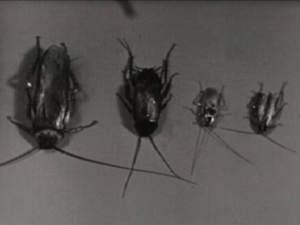I wasn’t even born yet in 1959 but roaches were definitely around. It’s interesting how much was known even this long ago about roaches and other pests. Scientists and researchers did an incredible job on laying the foundation for what we call modern extermination today. Of course the roaches haven’t paid any of these smart people much mind and even with all of our great advancements and products, they just seem to keep on rolling. The following video and text is from a 1959 public service educational film and it’s interesting to watch. Slightly edited for uploading purposes but still a fascinating piece with unrivaled cinematography by even today’s standards.
Recognize this gentleman? In english he is called cockroach, croton bug, roach water bug or black beetle. The germans call him schaben,the french La blatte and in spanish he is known as La cucaracha. No matter what the language or country the cockroach is an unwelcome and disgusting pest in any home.
Roaches are one of the oldest insects having lived in the days of the dinosaur. Fortunately for us the size of our roach today is extremely small compared to his ancestors. Roaches in the days of the dinosaurs were several feet long.Today some roaches found in the tropics grow 3 or 4 times larger than our common American cockroach.
The true home of the roach is outdoors beneath the bark of trees and under rocks. This has resulted in their bodies heads and legs becoming flattened allowing them to hide in small cracks and crevices. There are about 2000 different kinds of roaches but only 4 have adapted life indoors. The largest of theses is the American roach, adults may be from 1 1/2 to 2 inches long, reddish brown to dark brown in color.
The oriental roach sometimes called ‘black beetle’ because of their short wings, heavy body and dark color are slightly smaller than their American cousin. The brown banded roach is the smallest of our 4 kinds and brightest in color. They like high places such as the ceilings and cabinets in the kitchen, this makes them a little harder to control. The german roach is the most common and is often called the croton bug or water bug. Adults are slightly larger than the brown banded but are still less than 1 inch long and light brown in color. Here are all 4 together, left to right, the American, oriental, brown banded and the german.
and cabinets in the kitchen, this makes them a little harder to control. The german roach is the most common and is often called the croton bug or water bug. Adults are slightly larger than the brown banded but are still less than 1 inch long and light brown in color. Here are all 4 together, left to right, the American, oriental, brown banded and the german.
Roaches may come into a home several different ways, sewers or basement drains are one of the most common. They can also enter through any openings in the walls such as around any electrical conduits or plumbing. Or through cracks in the baseboards or under doors. Roaches can be carried into a home in laundry packages or in boxes of groceries. All packages which might possibly contain roaches should be examined carefully. If an adult carrying an egg capsule gets away a population of roaches is likely to develop. The capsule which may contain as many as 48 eggs is deposited in a hidden location. When the eggs develop into young roaches they push open the capsule to emerge. These young nymphs are extremely active and will begin searching for food immediately. A few days later the young roaches turn to a yellowish brown color.
Still in the nymph stage these roaches are almost grown but have not yet developed wings. Wings are present only on adults. After several generations a large colony will develop creating a very unpleasant odor in the house. Roaches destroy food, damage fabrics, books and  other materials. By polluting food over which they run they spread filth and may carry diseases. When roach populations build up their presence is easily noted by ‘roach spots’ in places they congregate such as in cabinets, drawers and behind pictures.
other materials. By polluting food over which they run they spread filth and may carry diseases. When roach populations build up their presence is easily noted by ‘roach spots’ in places they congregate such as in cabinets, drawers and behind pictures.
Roaches hide during the day in sheltered dark places, at night they come out in search of food and water. A good way to find roaches is to enter a dark room quietly, snap on the lights and watch where they run to hide. They may be found in cracks in the baseboard, around water pipes underneath the sink.
The development of insecticides has kept pace with our modern way of life. Today chemicals are available which will kill insects weeks after they’re applied. Through proper use of these chemicals by individuals and communities we can say “Good Bye Mr. Roach” our number 1 household pest.




